
This virus infects more than 150 types of plants, including many fruits, vegetables, and flowers. It is characterized by leaves mottled with yellow, white, and light and dark green spots or streaks. Some of the most commonly infected plants include tomatoes, potatoes, squash, and cucumbers. But will infect others.
Depending on environmental conditions, mosaic symptoms can range from mild to severe and be visible on both leaves and fruit. The younger the plant is infected, the more severe the symptoms as the plant grows and ages. In some cases, plants infected at the seedling stage may collapse and die. Plants infected at the flowering stage may not set fruit or young fruits may drop. If plants are older or grown when infected they do not show severe mosaic and can still produce edible fruit.
No chemical products are available to cure or protect plants. The best factor in controlling and reducing infection is to practice sanitation. Remove any infected plants, including the roots, Also discard any plants near those affected.
Like all viruses, mosaics are incurable- although sometimes they simply create interestingly patterned leaves without significantly reducing a plant’s vigor.
Leaves are mottled or streaked. Other possible symptoms include distorted or stunted growth, reduced yield, and poor fruit quality.
Control:Resistant varieties, certified disease-free stock, crop rotation, weeding, destroying infected plants.
Notes:Resistant varieties may be available for certain crops. Control weeds, since many serve as reservoirs for viruses. To avoid spreading tobacco mosaic virus, don’t smoke around tomato-family plants and wash your hands before touching them.

